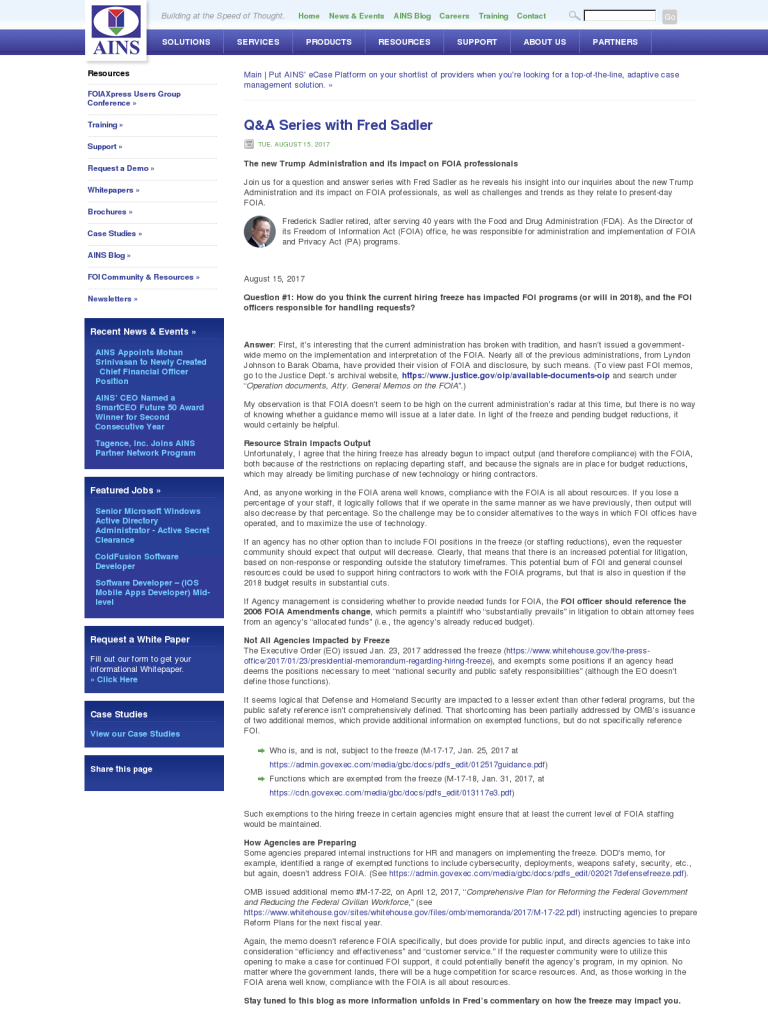Q&A Series with Fred Sadler
Blog: eCase Case Management Blog
The new Trump Administration and its impact on FOIA professionals
Join us for a question and answer series with Fred Sadler as he reveals his insight into our inquiries about the new Trump Administration and its impact on FOIA professionals, as well as challenges and trends as they relate to present-day FOIA.
 Frederick Sadler retired, after serving 40 years with the Food and Drug Administration (FDA). As the Director of its Freedom of Information Act (FOIA) office, he was responsible for administration and implementation of FOIA and Privacy Act (PA) programs.
Frederick Sadler retired, after serving 40 years with the Food and Drug Administration (FDA). As the Director of its Freedom of Information Act (FOIA) office, he was responsible for administration and implementation of FOIA and Privacy Act (PA) programs.
August 15, 2017
Question #1: How do you think the current hiring freeze has impacted FOI programs (or will in 2018), and the FOI officers responsible for handling requests?
Answer: First, it’s interesting that the current administration has broken with tradition, and hasn’t issued a government-wide memo on the implementation and interpretation of the FOIA. Nearly all of the previous administrations, from Lyndon Johnson to Barak Obama, have provided their vision of FOIA and disclosure, by such means. (To view past FOI memos, go to the Justice Dept.’s archival website, https://www.justice.gov/oip/available-documents-oip and search under “Operation documents, Atty. General Memos on the FOIA”.)
My observation is that FOIA doesn’t seem to be high on the current administration’s radar at this time, but there is no way of knowing whether a guidance memo will issue at a later date. In light of the freeze and pending budget reductions, it would certainly be helpful.
Resource Strain Impacts Output
Unfortunately, I agree that the hiring freeze has already begun to impact output (and therefore compliance) with the FOIA, both because of the restrictions on replacing departing staff, and because the signals are in place for budget reductions, which may already be limiting purchase of new technology or hiring contractors.
And, as anyone working in the FOIA arena well knows, compliance with the FOIA is all about resources. If you lose a percentage of your staff, it logically follows that if we operate in the same manner as we have previously, then output will also decrease by that percentage. So the challenge may be to consider alternatives to the ways in which FOI offices have operated, and to maximize the use of technology.
If an agency has no other option than to include FOI positions in the freeze (or staffing reductions), even the requester community should expect that output will decrease. Clearly, that means that there is an increased potential for litigation, based on non-response or responding outside the statutory timeframes. This potential burn of FOI and general counsel resources could be used to support hiring contractors to work with the FOIA programs, but that is also in question if the 2018 budget results in substantial cuts.
If Agency management is considering whether to provide needed funds for FOIA, the FOI officer should reference the 2006 FOIA Amendments change, which permits a plaintiff who “substantially prevails” in litigation to obtain attorney fees from an agency’s “allocated funds” (i.e., the agency’s already reduced budget).
Not All Agencies Impacted by Freeze
The Executive Order (EO) issued Jan. 23, 2017 addressed the freeze (https://www.whitehouse.gov/the-press-office/2017/01/23/presidential-memorandum-regarding-hiring-freeze), and exempts some positions if an agency head deems the positions necessary to meet “national security and public safety responsibilities” (although the EO doesn’t define those functions).
It seems logical that Defense and Homeland Security are impacted to a lesser extent than other federal programs, but the public safety reference isn’t comprehensively defined. That shortcoming has been partially addressed by OMB’s issuance of two additional memos, which provide additional information on exempted functions, but do not specifically reference FOI.
- Who is, and is not, subject to the freeze (M-17-17, Jan. 25, 2017 at https://admin.govexec.com/media/gbc/docs/pdfs_edit/012517guidance.pdf)
- Functions which are exempted from the freeze (M-17-18, Jan. 31, 2017, at https://cdn.govexec.com/media/gbc/docs/pdfs_edit/013117e3.pdf)
Such exemptions to the hiring freeze in certain agencies might ensure that at least the current level of FOIA staffing would be maintained.
How Agencies are Preparing
Some agencies prepared internal instructions for HR and managers on implementing the freeze. DOD’s memo, for example, identified a range of exempted functions to include cybersecurity, deployments, weapons safety, security, etc., but again, doesn’t address FOIA. (See https://admin.govexec.com/media/gbc/docs/pdfs_edit/020217defensefreeze.pdf).
OMB issued additional memo #M-17-22, on April 12, 2017, “Comprehensive Plan for Reforming the Federal Government and Reducing the Federal Civilian Workforce,” (see https://www.whitehouse.gov/sites/whitehouse.gov/files/omb/memoranda/2017/M-17-22.pdf) instructing agencies to prepare Reform Plans for the next fiscal year.
Again, the memo doesn’t reference FOIA specifically, but does provide for public input, and directs agencies to take into consideration “efficiency and effectiveness” and “customer service.” If the requester community were to utilize this opening to make a case for continued FOI support, it could potentially benefit the agency’s program, in my opinion. No matter where the government lands, there will be a huge competition for scarce resources. And, as those working in the FOIA arena well know, compliance with the FOIA is all about resources.
Stay tuned to this blog as more information unfolds in Fred’s commentary on how the freeze may impact you.
Leave a Comment
You must be logged in to post a comment.








